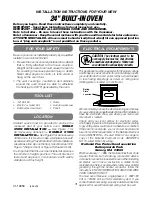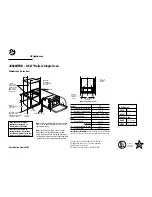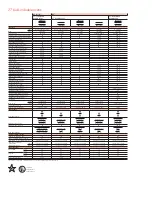
42
■
Food which lies flat will cook more quickly than food which is
piled high. You should therefore distribute the food so that it
is as flat as possible in the ovenware. Different foodstuffs
should not be placed in layers on top of one another.
■
Cook the food in ovenware with a lid. If you do not have a
suitable lid for your ovenware, use a plate or special
microwave foil.
■
This will help the food retain its own distinct taste, so it will
require less seasoning.
■
After cooking, allow the food to stand for a further 2 to
5 minutes so that it can achieve an even temperature.
■
Always use an oven cloth or oven gloves when removing
plates from the oven.
Microwave tips
Cakes and pastries
About the tables
Notes
■
The times given apply to food placed in a cold oven.
■
The temperature and baking time depend on the consistency
and amount of the mixture. This is why temperature ranges
are given in the tables. Begin with the lower temperature and,
if necessary, use a higher setting the next time, since a lower
temperature results in more even browning.
■
Additional information can be found in the
Baking tips
section
following the tables.
■
Always place the cake tin in the centre of the wire rack.
Baking tins
Note:
It is best to use dark-coloured metal baking tins.
Cooking food
Weight
Microwave power setting in
watts, cooking time in minutes
Notes
Whole chicken, fresh, no giblets
1.2 kg
600 W, 25-30 mins
Turn halfway through the cooking time
Fish fillet, fresh
400 g
600 W, 7-12 mins
-
Vegetables, fresh
250 g
600 W, 6-10 mins
Cut vegetables into pieces of equal size.
Add 1 to 2 tbsp water per 100 g of vegetables.
Stir during cooking
500 g
600 W, 10-15 mins
Sweet foods, e.g. blancmange
(instant)
500 ml
600 W, 6-8 mins
Stir the custard pudding thoroughly 2 to
3 times during cooking using an egg whisk.
Fruit, compote
500 g
600 W, 9-12 mins
-
Side dishes
e. g. potatoes
250 g
600 W, 8-10 mins
Cut the potatoes into pieces of equal size;
Add 1 to 2 tbsp water for every 100 g.
Stir during cooking
500 g
600 W, 12-15 mins
750 g
600 W, 15-22 mins
e.g. rice
125 g
600 W, 4-6 mins +
180 W, 12-15 mins
Add double the amount of liquid.
250 g
600 W, 6-8 mins +
180 W, 15-18 mins
You cannot find any information about the settings for the
quantity of food you have prepared.
Increase or reduce the cooking times using the following rule of
thumb:
Double the amount = almost double the cooking time
Half the amount = half the cooking time
The food has become too dry.
Next time, set a shorter cooking time or select a lower microwave
power setting. Cover the food and add more liquid.
When the time has elapsed, the food is not defrosted, hot or
cooked.
Set a longer time. Large quantities and food which is piled high
require longer times.
When the time has elapsed, the food is overheated at the
edge but not done in the middle.
Stir it during the cooking time and next time, select a lower micro-
wave power setting and a longer cooking time.
After defrosting, the poultry or meat is defrosted on the out-
side but not defrosted in the middle.
Next time, select a lower microwave power setting. If you are
defrosting a large quantity, turn it several times.
Cakes in tins
Accessories
Level
Type of
heating
Temperature °C Microwave power
in watts
Sponge cake, simple or sponge cake, del-
icate (e.g. sand cake)*
Ring-shaped cake tin/
Vienna ring tin/cake tin
1
1
3
3
160-170
150-160
60-80
60-70
Sponge flan base with crust made from
shortcrust pastry
Springform cake tin
1
3
160-170
35-45
Sponge flan base
Flan tin
1
3
160-170
35-45
Sponge flan (hot water sponge cake)
Springform cake tin
1
3
170-180
45-50
Cake with dry topping (sponge)
Baking tray
2
3
160-170
30-40
* Allow cake to cool in the oven for approx. 20 minutes.
** Never pour water directly into a hot oven.
















































